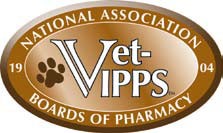Many pets need to take drugs that have been compounded, where the drug’s dosage, form, or flavor are manipulated to make them work for animals. Compounding pharmacies produce drugs in dosages suitable for small dogs, in flavors that pets are willing to eagerly eat, and in forms such as transdermal, where the drug is applied to the skin rather than given orally. They can sometimes be a source for drugs that have been discontinued as well. Because of their specialized nature, compounded drugs don’t go through a drug-approval process with the FDA, and so are not formally tested for safety or efficacy. Compounded drugs can be life-savers for some pets, but they can be ineffective if poor-quality ingredients are used, and dangerous when mistakes are made. The NABP doesn’t list any compounding pharmacies, although Choice Compounding Pharmacy (choicecompoundingpharmacy.com) was recently granted approval. In addition, there’s a separate organization, the Pharmacy Compounding Accreditation Board (PCAB) that focuses on this area of specialization. The PCAB was created in 2004 in an attempt by the pharmacy industry to police itself and raise the quality of compounded drugs. Go to its web site at pcab.info to search for accredited compounding pharmacies by state. Potential for mistakes The growing use of human pharmacies filling prescriptions for our dogs, however, means we may also have to deal with pharmacists who may know little or nothing about an animal’s needs, or have any idea of the size of the patient when filling the prescription. This ignorance can lead to serious, even fatal, errors. Although still possible, these kinds of errors are less likely to occur with prescriptions filled at your vet’s office, since the people filling the prescription know their patients and are familiar with common dosages for dogs. Incorrect dosage amounts are not the only mistakes that human pharmacists may make when filling prescriptions written for pets. Not all pharmacists currently receive training in the use of drugs for non-human patients. Some of the additives pr flavors that are commonly added to human medications can also be toxic to pets. In other cases, pharmacists may alter in good faith doses, believing they are correcting a veterinarian’s mistake, or substitute medications inappropriately, without notifying either the veterinarian or the client of the changes. This can lead to serious problems for some pets. These problems are not new, but they are increasing as more people turn to human pharmacies in order to save money on their pets’ prescriptions. Mistakes may also occur more frequently with large national chains that fill high volumes of prescriptions, where a pharmacist is unlikely to develop a personal relationship with either veterinarians or clients. Take-home message Whenever your vet gives you a prescription, make sure you understand the prescribed amount and dosing schedule. Then check the label to make sure that the name of the medication is the same as what your vet prescribed, and that the printed instructions match what your vet told you to give. If you have any questions about the medication, check with your vet, rather than relying on information from the pharmacist. If a pharmacy offers you a substitute medication, do not accept it until and unless you confirm with your vet that the substitution is acceptable. And never change your pet’s medication without consulting with your veterinarian.



Comments